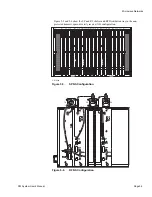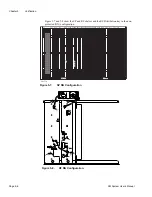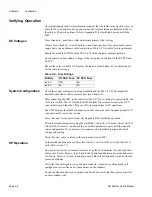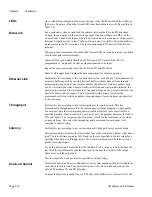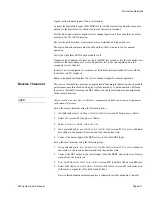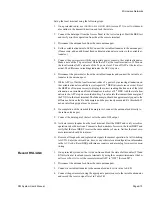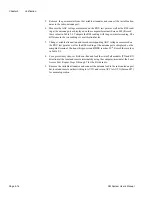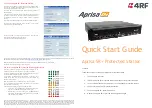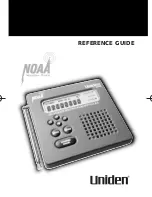
Chapter 5
Verification
Page 5-12
CM System User’s Manual
range of which must be greater than the difference in value between the receive signal
level (terminal reading) and the specified received threshold (specifications; Chp. 1).
This step also helps you select the correct power sensor to measure RSL.
5.
Disconnect the antenna feed from the radio antenna port.
6.
Set the variable attenuator to 0 dB and connect the attenuator to the antenna feed. If
necessary, add a fixed calibrated attenuator in series with the variable attenuator.
7.
Connect the power meter with the appropriate power sensor to the variable attenuator.
Make note of the nominal receive signal level (RSL).
8.
Disconnect the power meter from the variable attenuator and connect the variable at-
tenuator to the antenna port.
9.
Reduce RSL by increasing attenuation on attenuator until the test set shows 10
-6
BER.
Note total attenuation of the variable (plus fixed) attenuator that achieves 10
-6
BER.
Calculate receive threshold by subtracting total attenuation from nominal RSL.
10. On a protected radio, use
CONTROL
-
PATH
SWITCHING
(screen 071) and set B-side mod-
ules online in the receive direction and lock their online state.
Repeat Step 9 to determine the receive threshold on the secondary unit.
Note:
In hot standby receiver configuration, B-side receive filter experiences 10 dB more loss
than the A side; therefore, 10 dB less system gain.
11. After the test connect the antenna feed directly to the antenna port.
Enable AIS in the local terminal (screen 052). Enable the APC in the remote terminal
(set screen 087 to AUTO).
Connect the data output of the test set to the radio DS3 input and set remote loopback.
Start the BERT and verify error-free operation in both directions. Transmit a fixed
number of errors and verify the same number of errors at the receive side. The local
and remote terminals should show no alarms.
12. Remove loopbacks and replace DS3 input and output signals for normal operation.
Set path switching to AUTO. Enter current date, time, or any other relevant configura-
tion information in the ACU code. Reset BER performance counters and alarm log for
in-service monitoring.
Tx Fade Margin
The Tx fade margin test provides an approximate fade margin indication and displays
system immunity to path anomalies and unwanted interference signals. Perform Tx fade
margin test on RXUs at the remote terminal and configuration of the local terminal.
NOTE:
Actual results may vary due to cable loss accuracy, equipment, and path variation and
equipment calibration differences. Perform this test only after determining Rx fade margin.
Set up the remote terminal using the following steps:
1.
Check APC (Screen 051) using the LMT and QuikLink. If it is not enabled, remove
the ACU and close switch S3, rocker 8, to enable transmit APC. Re-seat the ACU.
2.
On a protected radio, use
CONTROL
-
PATH
SWITCHING
(screen 071) to set A-side mod-
ules online in the receive direction and lock their state.
3.
Connect the data input of the BER test set to the radio DS3 output.
Summary of Contents for CM7
Page 2: ......
Page 4: ...Page iv 5 04 05 CM7 8 100Base T System User s Manual ...
Page 16: ...Glossary Page xvi CM System Users Manual X Y Z ...
Page 24: ...Microwave Networks CM7 8 100Base T System User s Manual Pagexxiv ...
Page 62: ...Chapter 2 Operation Page 2 18 5 02 05 CM 100Base T System User s Manual ...
Page 64: ...Chapter 3 Module Descriptions Page 3 2 CM7 8 100Base T ...
Page 88: ...Section 3 3 Transmitter Unit Page 3 3 6 CM7 8 System User s Manual ...
Page 96: ...Section 3 5 RF Power Supply Unit Page 3 5 4 CM System User s Manual ...
Page 100: ...Section 3 6 SP Power Supply Unit Page 3 6 4 CM System User s Manual ...
Page 106: ...Section 3 7 Alarm and Control Unit Page 3 7 6 11 18 03 CM 100Base T System User s Manual ...
Page 124: ...Section 3 11 SYNDES Page 3 11 6 CM System User s Manual ...
Page 130: ...Section 3 12 SCU Page 3 12 6 11 18 03 CM 100Base T System User s Manual ...
Page 138: ...Section 3 13 OWU Page 3 13 8 CM System User s Manual ...
Page 150: ...Section 3 15 NMU Page 3 15 6 CM System User s Manual ...
Page 192: ...Chapter 5 Verification Page 5 20 CM System User s Manual ...
Page 194: ...Chapter 6 Maintenance Page 6 2 7 23 03 CM 100Base T System User s Manual ...
Page 224: ...Chapter 6 Maintenance Page 6 32 7 23 03 CM 100Base T System User s Manual ...
Page 226: ...Site Engineering Page 2 CM System User s Manual ...
Page 230: ...Appendix A T I Curves Page A 4 CM7 8 100Base T System User s Manual ...
Page 267: ...Microwave Networks CM System User s Manual PageB 37 ...
Page 268: ...Appendix B QuikLink Page B 38 CM System User s Manual ...
Page 282: ...Appendix D Alarm Codes Page D 6 5 02 05 CM 100Base T System User s Manual ...
Page 290: ...Appendix E Setting Frequency Page E 8 CM7 8 System User s Manual ...
Page 312: ...CM7 8 100Base T System User s Manual Page I 4 Microwave Networks ...








